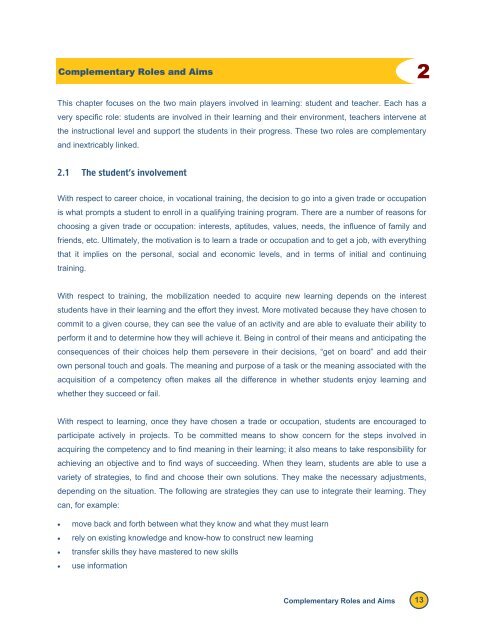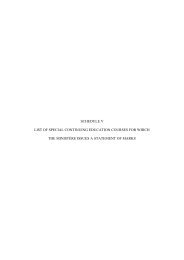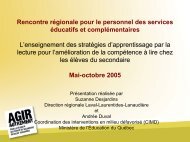Reference Framework for Planning Learning and Evaluation Activities
Reference Framework for Planning Learning and Evaluation Activities
Reference Framework for Planning Learning and Evaluation Activities
Create successful ePaper yourself
Turn your PDF publications into a flip-book with our unique Google optimized e-Paper software.
Complementary Roles <strong>and</strong> Aims<br />
2<br />
This chapter focuses on the two main players involved in learning: student <strong>and</strong> teacher. Each has a<br />
very specific role: students are involved in their learning <strong>and</strong> their environment, teachers intervene at<br />
the instructional level <strong>and</strong> support the students in their progress. These two roles are complementary<br />
<strong>and</strong> inextricably linked.<br />
2.1 The student’s involvement<br />
With respect to career choice, in vocational training, the decision to go into a given trade or occupation<br />
is what prompts a student to enroll in a qualifying training program. There are a number of reasons <strong>for</strong><br />
choosing a given trade or occupation: interests, aptitudes, values, needs, the influence of family <strong>and</strong><br />
friends, etc. Ultimately, the motivation is to learn a trade or occupation <strong>and</strong> to get a job, with everything<br />
that it implies on the personal, social <strong>and</strong> economic levels, <strong>and</strong> in terms of initial <strong>and</strong> continuing<br />
training.<br />
With respect to training, the mobilization needed to acquire new learning depends on the interest<br />
students have in their learning <strong>and</strong> the ef<strong>for</strong>t they invest. More motivated because they have chosen to<br />
commit to a given course, they can see the value of an activity <strong>and</strong> are able to evaluate their ability to<br />
per<strong>for</strong>m it <strong>and</strong> to determine how they will achieve it. Being in control of their means <strong>and</strong> anticipating the<br />
consequences of their choices help them persevere in their decisions, “get on board” <strong>and</strong> add their<br />
own personal touch <strong>and</strong> goals. The meaning <strong>and</strong> purpose of a task or the meaning associated with the<br />
acquisition of a competency often makes all the difference in whether students enjoy learning <strong>and</strong><br />
whether they succeed or fail.<br />
With respect to learning, once they have chosen a trade or occupation, students are encouraged to<br />
participate actively in projects. To be committed means to show concern <strong>for</strong> the steps involved in<br />
acquiring the competency <strong>and</strong> to find meaning in their learning; it also means to take responsibility <strong>for</strong><br />
achieving an objective <strong>and</strong> to find ways of succeeding. When they learn, students are able to use a<br />
variety of strategies, to find <strong>and</strong> choose their own solutions. They make the necessary adjustments,<br />
depending on the situation. The following are strategies they can use to integrate their learning. They<br />
can, <strong>for</strong> example:<br />
• move back <strong>and</strong> <strong>for</strong>th between what they know <strong>and</strong> what they must learn<br />
• rely on existing knowledge <strong>and</strong> know-how to construct new learning<br />
• transfer skills they have mastered to new skills<br />
• use in<strong>for</strong>mation<br />
Complementary Roles <strong>and</strong> Aims 13




